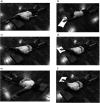Reliability of two devices for shoulder strength assessment: Wii Fit Balance Board and hand-held dynamometer
- PMID: 38425742
- PMCID: PMC10901178
- DOI: 10.1177/17585732221145558
Reliability of two devices for shoulder strength assessment: Wii Fit Balance Board and hand-held dynamometer
Abstract
Background: The aim of this study was to compare the reliability and agreement between two devices - Wii Fit Balance Board (WBB) versus Hand-Held Dynamometer (HHD) to measure isometric strength during the athletic shoulder (ASH) test in healthy amateur rugby players.
Methods: Fifteen males (23.73 ± 2.8 years) completed two testing sessions. Maximal isometric contractions using the dominant arm (D) and non-dominant arm (ND) against a WBB and HHD were assessed at three angles of abduction (180°, 'I'; 135°, 'Y' and 90°, 'T'), in a prone lying position.
Results: The results indicate a very large correlation between the HHD and the WBB. WBB provides acceptable reliability at I-Test D (CV = 9.97%, ICC = 0.88) and HHD in the I-Test D (CV = 8.90%, ICC = 0.94), I-Test ND (CV = 8.60%, ICC = 0.95) in peak strength values. The HHD is most reliable in D ASH I-Y-T (CV = 10.94%) and WBB (CV = 11.05%). In the ND ASH I-Y-T test, the HHD is the most reliable (CV = 12.5%) compared to the WBB (CV = 14.43%).
Conclusions: These results suggest that WBB is a reliable device to assess strength in the ASH test with a very large correlation with the HHD. WBB and HHD are two affordable devices to assess isometric shoulder strength.
Keywords: Reliability; isometric; shoulder; strength; upper extremity.
© The Author(s) 2022.
Conflict of interest statement
The authors declared no potential conflicts of interest with respect to the research, authorship, and/or publication of this article.
Figures




Similar articles
-
The Athletic Shoulder (ASH) test: reliability of a novel upper body isometric strength test in elite rugby players.BMJ Open Sport Exerc Med. 2018 Jul 23;4(1):e000365. doi: 10.1136/bmjsem-2018-000365. eCollection 2018. BMJ Open Sport Exerc Med. 2018. PMID: 30057775 Free PMC article.
-
Isometric hand grip strength measured by the Nintendo Wii Balance Board - a reliable new method.BMC Musculoskelet Disord. 2016 Feb 3;17:56. doi: 10.1186/s12891-016-0907-0. BMC Musculoskelet Disord. 2016. PMID: 26842966 Free PMC article. Clinical Trial.
-
RELIABILITY, COMPARABILITY, AND VALIDITY OF FOOT INVERSION AND EVERSION STRENGTH MEASUREMENTS USING A HAND-HELD DYNAMOMETER.Int J Sports Phys Ther. 2016 Feb;11(1):72-84. Int J Sports Phys Ther. 2016. PMID: 26900502 Free PMC article.
-
Novel Use of the Nintendo Wii Board for Measuring Isometric Lower Limb Strength: A Reproducible and Valid Method in Older Adults.PLoS One. 2015 Oct 7;10(10):e0138660. doi: 10.1371/journal.pone.0138660. eCollection 2015. PLoS One. 2015. PMID: 26444554 Free PMC article.
-
Test-retest reliability and concurrent validity of knee extensor strength measured by a novel device incorporated into a weight stack machine vs. handheld and isokinetic dynamometry.PLoS One. 2024 May 22;19(5):e0301872. doi: 10.1371/journal.pone.0301872. eCollection 2024. PLoS One. 2024. PMID: 38776288 Free PMC article.
Cited by
-
Investigation of the intra and inter-day reliability of the athletic shoulder test using the wii balance board in volleyball players.BMC Sports Sci Med Rehabil. 2025 Jul 2;17(1):158. doi: 10.1186/s13102-025-01185-4. BMC Sports Sci Med Rehabil. 2025. PMID: 40605000 Free PMC article.
References
-
- Stark T, Walker B, Phillips JKet al. et al. Hand-held dynamometry correlation with the gold standard isokinetic dynamometry: a systematic review. PM R 2011; 3: 472–479. - PubMed
-
- Hopkins WG, Hawley JA, Burke LM. Design and analysis of research on sport performance enhancement. Med Sci Sports Exerc 1999; 31: 472–485. - PubMed
-
- Hopkins WG. Measures of reliability in sports medicine and science. Sports Med 2000; 30: 1–15. - PubMed
-
- Hopkins WG, Schabort EJ, Hawley JA. Reliability of power in physical performance tests. Sports Med 2001; 31: 211–234. - PubMed
LinkOut - more resources
Full Text Sources
Research Materials
Miscellaneous
